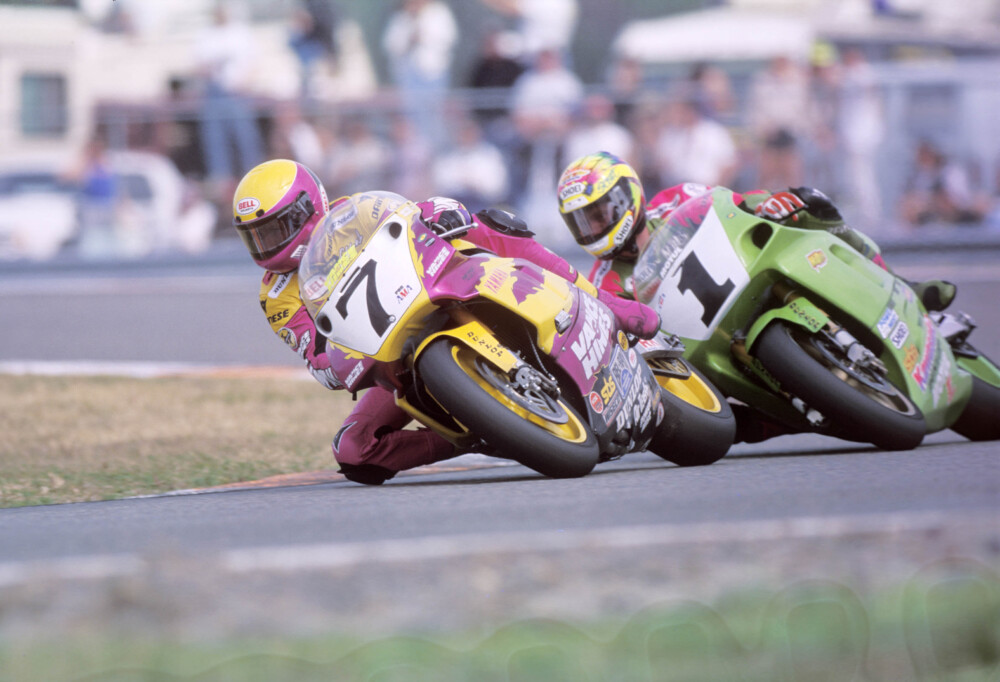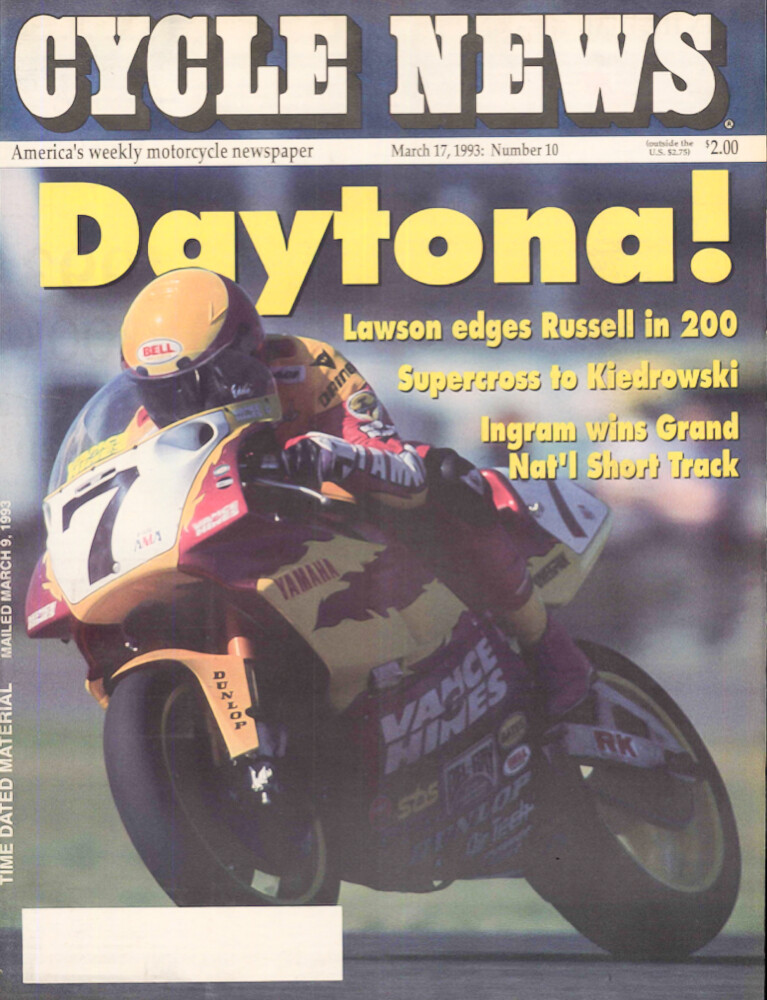Rennie Scaysbrook | March 19, 2023
Cycle News Archives
COLUMN
Steady Eddie’s Final Win
Thirty years ago, America’s greatest-ever MotoGP rider, Eddie Lawson, pulled himself out of a well-earned retirement for an appearance on the Vance & Hines Yamaha YZF750 at the Daytona 200.
Lawson had previously taken victory in the great race in 1986 while at the height of his powers in GP racing when many international stars would come to Florida for a bit of preseason bump and barge before heading back to the piranha bowl of European racing.
But 1993 was different.
 Eddie Lawson’s (7) final fling put him on the top step at Daytona in a thriller over Scott Russell (1). Photo by Henny Ray Abrams
Eddie Lawson’s (7) final fling put him on the top step at Daytona in a thriller over Scott Russell (1). Photo by Henny Ray Abrams
Ready to embark on what would be a short but successful switch to four-wheel competition in which he would eventually get on the IndyCar grid, Lawson had nothing to prove in the two-wheeled space after a decade of wrestling history’s most evil race bikes in the 1980s, the 500cc two-strokes.
What’s more, the 200 was still seen as one of the premier races on the international calendar, and although the day’s current GP stars were not facing the starter’s flag, there was a plethora of young and established stars from AMA and WorldSBK, the series which was beginning to find its feet after its 1988 establishment and would eventually go on to surpass 500cc GP racing’s popularity by the end of the 1990s.
The list of entries makes for compelling reading. Lawson would have to contend with current 200 Champion and eventual 1993 WorldSBK Champion Scott Russell, the man who in time would go on to take a record five 200 wins and own the nickname “Mr. Daytona.”
Former two-time WorldSBK Champion Doug Polen was there, soon to be two-time WorldSBK Champion, but then a 19-year-old upstart by the name of Colin Edwards was Lawson’s teammate; Kiwi legend Aaron Slight was on the grid, as was Miguel Duhamel, Pascal Picotte, Steve Crevier, Ducati’s first WorldSBK Champion Raymond Roche, Japan’s Akira Yanagawa, Scotland’s Brian Morrison, and the late Briton Mark Farmer, Dale Quarterly and Ireland’s plucky GP and TT journeyman Eddie Laycock.
Lawson may have had some solid competition against him, but he had the right kit for the job. The Jim Leonard-built Vance & Hines Yamaha YZF750 was a missile around the high banks with more top-end speed than Russell’s number-one Muzzy Kawasaki, although the 1993 Daytona 200 was more a race of tires than any horsepower advantage.
This was the first time in the race’s history that the leaders would stop for three rear-tire changes, which meant the race was largely a case of cat-and-mouse of who made the correct choice and who made their choices last.
As it turned out, the top four finishers all needed three rears to go the distance at the pace they were running, although Russell and Lawson both bet on a two-stop strategy, only for each to make unscheduled pitstops and throw the running order out of whack.
The 1993 Daytona 200 was a tragic event with the death of 36-year-old Jimmy Adamo, the New Yorker who passed away following a high-speed crash on lap seven. According to eyewitness accounts, Adamo ran straight at the end of the backstraight that leads to turn six, the left-hander that puts riders back onto the high-banked oval. Adamo lost control of his Ducati and struck a section of haybale-protected wall, suffering fatal head injuries.
At the time of Adamo’s accident, Russell and Lawson had established themselves as the front-runners, with the former taking over at the front in lap seven when the pace car was brought out.
With the pace car in on lap 12, the battle resumed, but this time Lawson and Russell had been caught by Duhamel, but a false neutral for the French-Canadian meant he dropped back to sixth, and any hopes of victory, even at this early stage, were gone.
“I was catching up to Eddie and Scott and I said, ‘Okay, I’ll get in their draft and race to the end,’ ” Duhamel said. “I was pretty happy about that part of the race, but then I got a false neutral and I didn’t take any chances. I took it straight and that’s the ground I couldn’t make up for the victory.”
By lap 16, Polen and Edwards had climbed into the top 10 after their dismal qualifying races saw them start 15th and 18th, respectively, but the race had already distilled into a battle between the old warhorse Lawson and the young buck, Russell, with Slight now cemented in third.
Lap 17 saw Russell pit for fuel and a new rear tire, with Lawson doing the same on lap 21. But there was a wrench in the works in the shape of Polen, who had gambled on a one-stop strategy by fitting the hardest tire he could get. But by lap 25, the tire started to vibrate, and Polen’s hopes were gone as he made a mercy dash into the pits for a new rear. He rejoined at the back of the top 10.
Edwards’ race was over roughly the same time as Polen’s after his Yamaha “just quit,” he said. “It didn’t make any funny noises or anything, it just quit running.”
With Polen taken care of, Russell moved back into the lead from Roche, Slight and Lawson. Steady Eddie quickly disposed of the two in front and set off after Russell, 6.5 seconds up the road. The four-time MotoGP Champion was riding so hard he ruined his second rear tire, so on lap 31, Lawson made the call to pit for a second unscheduled rear tire. His crew wasn’t ready for him, and when he rejoined the fray, Lawson was down in fifth.
But the tide was turning. Two laps later, Russell dashed into the pits for another rear and a splash of fuel. This time, however, Russell’s crew was ready for him, and a fast Muzzy Kawasaki team got the number one back in the race in third place and, importantly, in front of Lawson.
Lap 39 saw Duhamel and Yanagawa pit, Slight a lap later, meaning Russell was now in front of Lawson by 3.5 seconds.
Lawson knew it was now or never. By lap 42, the gap was down to 2.6 seconds. Lap 44, down to 1.7 seconds, and on lap 46, Lawson pounced and took the lead on the front straight. However, the tire gremlins weren’t banished yet, as Lawson pitted for a third rear on lap 48, Russell a third rear one lap later.
They emerged 1-2, with Russell holding a light advantage over Lawson, and on the 57th and final lap, the two were glued together. Russell held sway but encountered a lapper, a man who would go on to provide a huge amount of Yamaha’s team success over the next 25 years, Chuck Graves, at the final chicane.
Russell was held up just enough by Graves for Lawson to position himself perfectly for the run to the line, and the GP legend used the all-famous slingshot to take his final two-wheeled win by just 0.051 seconds.

“Boy, I’ll tell you what, my heart rate must have been over 200!” Lawson beamed from Victory Lane. “I just thought if I got behind Scott, I could draft him down the front straight and pull this thing off. Scott just about collected that guy [Graves] in the chicane, so I went right up to the top of the banking and just pinned it. We had enough horsepower that we beat him to the line. This thing’s fast.”
The 1993 Daytona 200 marked the final victory of Eddie Lawson’s two-wheeled career and the beginning of Scott Russell’s international fame. Lawson would turn his attention to a brief four-wheel IndyCar (CART) racing career, taking a best finish of sixth at the Michigan International Speedway. Russell would go on to take the 1993 WorldSBK Championship, the third for an American behind Polen and two-time champion Fred Merkel, and three more Daytona 200 victories for Kawasaki. CN